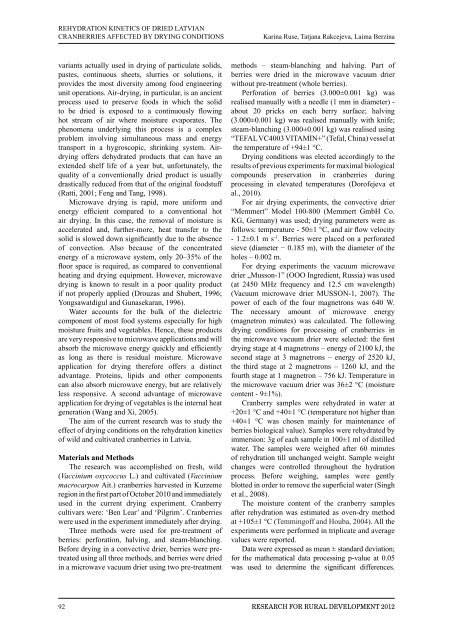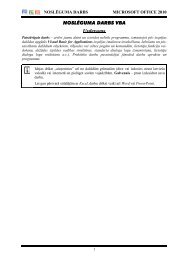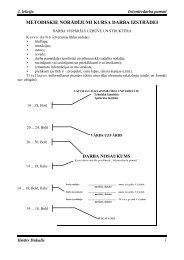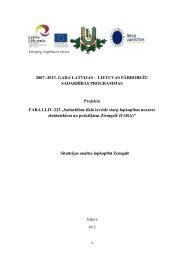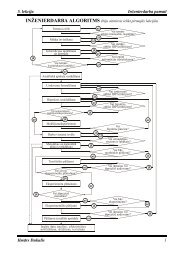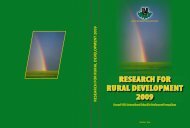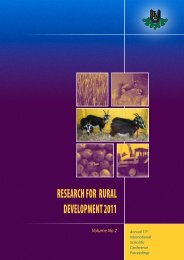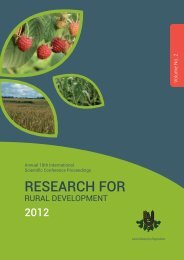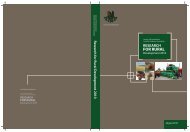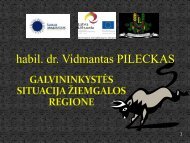LATVIA UNIVERSITY OF AGRICULTURE - Latvijas ...
LATVIA UNIVERSITY OF AGRICULTURE - Latvijas ...
LATVIA UNIVERSITY OF AGRICULTURE - Latvijas ...
- No tags were found...
You also want an ePaper? Increase the reach of your titles
YUMPU automatically turns print PDFs into web optimized ePapers that Google loves.
REHYDRATION KINETICS <strong>OF</strong> DRIED <strong>LATVIA</strong>NCRANBERRIES AFFECTED BY DRYING CONDITIONSKarina Ruse, Tatjana Rakcejeva, Laima Berzinavariants actually used in drying of particulate solids,pastes, continuous sheets, slurries or solutions, itprovides the most diversity among food engineeringunit operations. Air-drying, in particular, is an ancientprocess used to preserve foods in which the solidto be dried is exposed to a continuously flowinghot stream of air where moisture evaporates. Thephenomena underlying this process is a complexproblem involving simultaneous mass and energytransport in a hygroscopic, shrinking system. Airdryingoffers dehydrated products that can have anextended shelf life of a year but, unfortunately, thequality of a conventionally dried product is usuallydrastically reduced from that of the original foodstuff(Ratti, 2001; Feng and Tang, 1998).Microwave drying is rapid, more uniform andenergy efficient compared to a conventional hotair drying. In this case, the removal of moisture isaccelerated and, further-more, heat transfer to thesolid is slowed down significantly due to the absenceof convection. Also because of the concentratedenergy of a microwave system, only 20–35% of thefloor space is required, as compared to conventionalheating and drying equipment. However, microwavedrying is known to result in a poor quality productif not properly applied (Drouzas and Shubert, 1996;Yongsawatdigul and Gunasekaran, 1996).Water accounts for the bulk of the dielectriccomponent of most food systems especially for highmoisture fruits and vegetables. Hence, these productsare very responsive to microwave applications and willabsorb the microwave energy quickly and efficientlyas long as there is residual moisture. Microwaveapplication for drying therefore offers a distinctadvantage. Proteins, lipids and other componentscan also absorb microwave energy, but are relativelyless responsive. A second advantage of microwaveapplication for drying of vegetables is the internal heatgeneration (Wang and Xi, 2005).The aim of the current research was to study theeffect of drying conditions on the rehydration kineticsof wild and cultivated cranberries in Latvia.Materials and MethodsThe research was accomplished on fresh, wild(Vaccinium oxycoccus L.) and cultivated (Vacciniummacrocarpon Ait.) cranberries harvested in Kurzemeregion in the first part of October 2010 and immediatelyused in the current drying experiment. Cranberrycultivars were: ‘Ben Lear’ and ‘Pilgrim’. Cranberrieswere used in the experiment immediately after drying.Three methods were used for pre-treatment ofberries: perforation, halving, and steam-blanching.Before drying in a convective drier, berries were pretreatedusing all three methods, and berries were driedin a microwave vacuum drier using two pre-treatmentmethods – steam-blanching and halving. Part ofberries were dried in the microwave vacuum drierwithout pre-treatment (whole berries).Perforation of berries (3.000±0.001 kg) wasrealised manually with a needle (1 mm in diameter) -about 20 pricks on each berry surface; halving(3.000±0.001 kg) was realised manually with knife;steam-blanching (3.000±0.001 kg) was realised using“TEFAL VC4003 VITAMIN+” (Tefal, China) vessel atthe temperature of +94±1 °C.Drying conditions was elected accordingly to theresults of previous experiments for maximal biologicalcompounds preservation in cranberries duringprocessing in elevated temperatures (Dorofejeva etal., 2010).For air drying experiments, the convective drier“Memmert” Model 100-800 (Memmert GmbH Co.KG, Germany) was used; drying parameters were asfollows: temperature - 50±1 °C, and air flow velocity- 1.2±0.1 m s -1 . Berries were placed on a perforatedsieve (diameter − 0.185 m), with the diameter of theholes – 0.002 m.For drying experiments the vacuum microwavedrier „Musson-1” (OOO Ingredient, Russia) was used(at 2450 MHz frequency and 12.5 cm wavelength)(Vacuum microwave drier MUSSON-1, 2007). Thepower of each of the four magnetrons was 640 W.The necessary amount of microwave energy(magnetron minutes) was calculated. The followingdrying conditions for processing of cranberries inthe microwave vacuum drier were selected: the firstdrying stage at 4 magnetrons – energy of 2100 kJ, thesecond stage at 3 magnetrons – energy of 2520 kJ,the third stage at 2 magnetrons – 1260 kJ, and thefourth stage at 1 magnetron – 756 kJ. Temperature inthe microwave vacuum drier was 36±2 °C (moisturecontent - 9±1%).Cranberry samples were rehydrated in water at+20±1 °C and +40±1 °C (temperature not higher than+40±1 °C was chosen mainly for maintenance ofberries biological value). Samples were rehydrated byimmersion: 3g of each sample in 100±1 ml of distilledwater. The samples were weighed after 60 minutesof rehydration till unchanged weight. Sample weightchanges were controlled throughout the hydrationprocess. Before weighing, samples were gentlyblotted in order to remove the superficial water (Singhet al., 2008).The moisture content of the cranberry samplesafter rehydration was estimated as oven-dry methodat +105±1 °C (Temmingoff and Houba, 2004). All theexperiments were performed in triplicate and averagevalues were reported.Data were expressed as mean ± standard deviation;for the mathematical data processing p-value at 0.05was used to determine the significant differences.92 Research for Rural Development 2012


